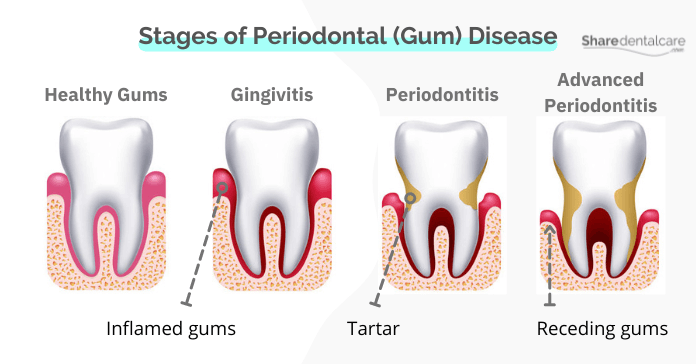Periodontal disease, also known as gum disease, is a bacterial infection that affects the tissues and bones that support teeth. It is caused by bacteria in dental plaque, a sticky film that develops on teeth. These bacteria irritate the gums and cause them to become inflamed. If left untreated, the infection may spread to the tooth-supporting tissues, leading to tooth loss. Periodontal disease can affect not just your teeth but also your overall health. In this blog post, We will discuss what periodontal (gum) disease is, its symptoms, and how to treat it.
How Does Periodontal (Gum) Disease Develop?
Periodontal (gum) disease is typically caused by a buildup of plaque on the teeth. This plaque is a sticky, colorless film made of bacteria, saliva, and food debris. If the plaque is not removed daily through brushing and flossing, it will harden into calculus (tartar). The plaque’s bacteria produce toxins that irritate and inflame the gums. This stage is known as gingivitis. If left untreated, the infection may spread to the tissues and bones that support the teeth, leading to Periodontitis, an advanced stage of gum disease.
Stages of Gum Disease
Periodontal (gum) disease can be categorized into:
- Gingivitis: An early stage of gum disease that is characterized by inflammation and redness of the gums. Gingivitis can be reversed with proper oral hygiene and regular dental cleanings.
- Periodontitis: A more advanced stage of gum disease that is characterized by inflammation, infection, and damage of the tissues and bones that support the teeth. In this stage, gums pull away from the teeth, creating pockets that can be deeper than 4 millimeters. Periodontitis requires more extensive treatment, such as scaling and root planing.
- Advanced Periodontitis: A severe form of gum disease that causes significant damage to the tissue and bone that support the teeth that usually requires surgery to treat. At this stage, tooth loss may occur.

Risk Factors
Periodontal (gum) disease is largely preventable, but certain factors can increase the risk of developing it. These include:
- Poor oral hygiene
- Smoking or using tobacco products
- Dry mouth or a lack of saliva
- Hormonal changes, such as those that occur during pregnancy
- Stress
- Some types of dental devices, such as braces
- Certain medical conditions, such as diabetes or HIV/AIDS
- Certain medications, including steroids and some blood pressure medications
- Genetics
You can learn more about how smoking can cause periodontal disease.
What’re The Symptoms of Periodontal (Gum) Disease?
Healthy gums are pink and firm and fit snugly around the teeth. If you have periodontal (gum) disease, you may experience one or more of the following symptoms:
- Red, swollen gums
- Tenderness or bleeding of the gums
- Gums that bleed easily during brushing and flossing
- Persistent bad breath or a bad taste in the mouth
- The spaces between teeth and gums become deeper. You can read more about periodontal pockets symptoms.
- Receding gums (gums that pull away from the teeth)
- Pus between the teeth and gums
- Loose or shifting teeth
- A change in the way the teeth fit together when biting
- Tooth loss
If you experience any of these symptoms, it is important to see your dentist right away. The earlier the condition is diagnosed and treated, the better the outcome.
Complications of Periodontal (Gum) Disease
Periodontal (gum) disease can lead to serious consequences if it is not treated. It can damage the tissues and bones that support teeth, leading to tooth loss. In addition, gum disease is linked to other serious health conditions such as stroke, heart attack, diabetes, premature birth, and low birth weight. Studies have also shown that periodontal (gum) disease can worsen existing conditions such as diabetes and heart disease.
How Is Periodontal (Gum) Disease Treated?
The treatment for periodontal (gum) disease depends on the severity of the condition. Generally, the goal of treatment is to reduce inflammation and stop the progression of the disease. Common treatments include:
- Professional teeth cleaning (routine cleaning): In the early stages of gum disease, professional cleaning may be sufficient to remove plaque and tartar from the teeth. This procedure is usually performed every 6 months.
- Scaling and root planing (deep cleaning): In more advanced cases, the dentist may recommend scaling and root planing. This procedure involves cleaning beneath the gum line to remove plaque and tartar buildup, as well as smoothing out rough surfaces of the teeth to prevent bacteria from collecting.
- Antibiotics: Oral antibiotics may be prescribed to help fight bacterial infection and reduce inflammation. Topical antibiotics may also be applied directly to the gums.
- Surgery: In extreme cases, surgery may be necessary to repair damage caused by gum disease. This may include pocket reduction (flap) surgery and tissue grafting to rebuild the gums or the bones that support the teeth.
No matter what stage of gum disease you are in, it is important to receive regular dental checkups and practice good oral hygiene. This will help to ensure the best outcome for your gum health.

Home Care
In addition to professional dental care, there are also some things you can do at home to help reduce inflammation and speed up the healing process. These include:
- Brushing your teeth at least twice a day and flossing regularly
- Using a fluoride toothpaste
- Using an antibacterial mouthwash to reduce bacteria in the mouth
- Quitting smoking
- Eating a healthy diet and avoiding sugary foods
- Drinking plenty of water
Taking these steps can help keep your gums healthy and prevent the progression of periodontal (gum) disease. It is also important to schedule regular dental checkups so that any changes in your oral health can be detected and treated quickly.
Conclusion
Periodontal disease, also known as gum disease, occurs when bacteria build up around the teeth and gums, resulting in inflammation and damage to the gums and tooth-supporting tissue. Periodontal (gum) disease can lead to tooth loss and other health complications if not treated. Treatment varies depending on the severity and may include professional cleaning, scaling and root planing, antibiotics, or surgery.
In addition to professional dental care, proper home care is essential to prevent and treat periodontal (gum) disease. This includes brushing your teeth twice a day, flossing regularly, and using an antibacterial mouthwash. Early diagnosis and treatment are essential for a successful outcome, so it is important to visit your dentist regularly.